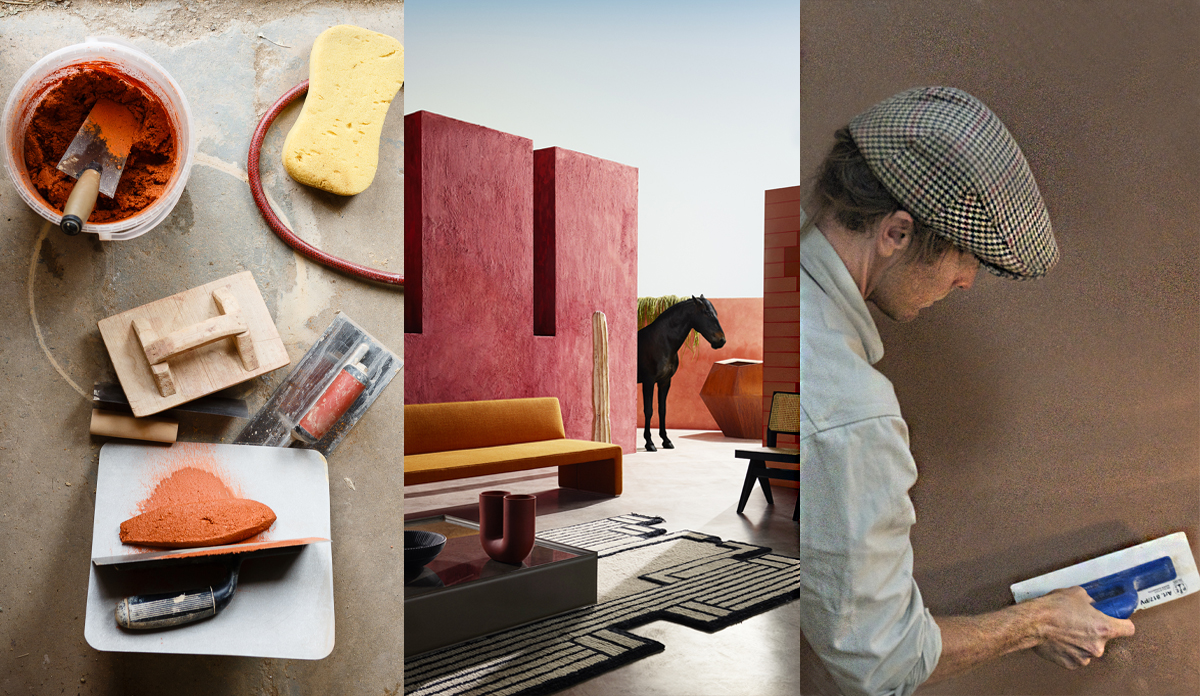Product Description

1. OVERVIEW
A pre-mixed, pre-pigmented interior wall & ceiling plaster, ready to mix with water. Apply with traditional plastering skills and tools. 100% natural*: all compostable.
*The majority of our Finishes are pigmented with natural, organic pigments. However, some colours contain chemical pigments – please contact us for further advice. Glazes and Primers may contain synthetics or chemicals.
2. SUPPLY
25 kg bags of dried plaster. Recyclable or compostable bags.
3. CLASSIC FINISHES
Smooth – Tonal – Demi-rustic – Rustic.
4. CUSTOM FINISHES
Rammed earth, colour ombre, two-tone anaglyptic, corrugated, etc.
For the complete list of custom finishes click here.
5. SUSTAINABILITY
Extremely low embodied carbon: 0.048 – 0.068 kg CO2 e/kg. (LCA stages A1-A3. Full A1 – D assessment is available in our EPD).
Product and packaging are fully compostable at all stages of lifecycle.*
* The majority of our Finishes are pigmented with natural, organic pigments. However, some colours contain chemical pigments – please contact us for further advice. Glazes and Primers may contain synthetics or chemicals.
6. HEALTH
Natural, low VOCs, formaldehydes, no polymers or oils. Absorbs toxins, regulates humidity. No off-gassing. Health Product Declaration & VOC Emissions Certificates.
May contain chemical pigments. Please ask us for further advice.
VOC emissions specifications in LEED EQ credit “Low -Emitting Materials” for LEED projects globally: The requirements of LEEDv4 and LEED v4.1 BETA (February 2021): CDPH-IAQ (California Department of Public Health (CDPH) Standard Method v1.2 – 2017); and a TVOC below 0.5 mg/m3 in both office and class room.
VOC content specifications in LEED EQ credit “Low-Emitting Materials” for LEED projects globally:
The requirements of LEED v4 and LEED v4.1 BETA (February 2021): South Coast Air Quality Management District (SCAQMD) Rule 1113 (2016) for Trowel Applied Coatings having a VOC content below 50 g/l.
7. OTHER ESSENTIALS
Clayworks Wall Primer & Clayworks Glaze (supplied by Clayworks with all clay orders plaster for additional cost).
8. APPLICATION
We strongly recommend application by an approved Clayworks plasterer. Where not possible, follow our application guidelines.
9. COLOURS
88 Standard colours. Custom colours available on request. UV resistant. Through pigmented.
10. COMPOSITION
Unique blends of unfired clays mixed with natural minerals and pigments.
11. SUBSTRATE
Most commonly applied directly onto gypsum plasterboard, masonry, block work, wood fibre board & wood wool carrier board. Can be applied directly onto gypsum backing board suitably primed. Other substrates may require a backing coat. For details please also see our separate data sheet ‘Clayworks Design Details‘.
Cannot be applied directly onto wood, including plywood, MDF or OSB.
12. RESTRICTIONS ON USE
Suitable for interior walls and ceilings and fixed furniture. Appropriate for bathrooms, but not wet or shower areas. We advise against use on items that will be moved around or doors. Not suitable for floors. Clayworks supply interior waterproof finishes and exterior grade finishes where a seamless match is required.
13. COUNTRY OF ORIGIN
UK. Manufactured in Cornwall.
14. FIRE
BS 476: Part 7: 1997 Surface spread of flame: achieved Class 1.
BS 476: Part 6: 1989 + A1: 2009 Fire Propagation test: fire propagation index I = 0.5, i1 = 0.0.
The results confirm that the plasters fulfil the following: UK Building Regulations: Class 0.
Class 0 is defined as: BS 476-7 Surface spread of flame Class 1, and BS 476-6 Fire propagation index test (I < 12, i1 < 6)
Euroclass A1 Fire Rating to EN13501 and EN15824 international standards.
Please also see our Clayworks Fire Certification.
15. HEALTH & SAFETY
As a powdered product a dust mask should always be worn when handling the product. Non Caustic.
16. ACOUSTICS
Noise Reduction Coefficient (NRC): Demi 0.15; Rustic 0.20 NRC depending on backing board. Sound absorption Coefficient tests conducted in accordance with British Standard BS EN ISO 354 available.
17. MAINTENANCE
Can be wiped clean with a non-toxic cleaner when glazed. Seamless. Easily repaired. Fixtures, fittings, wall hangings as per any other plaster.
18. DRYING TIMES
2-3 hours each layer, depending on temperature & humidity.
19. IMPACT
BS EN 520 – Impact Diameter < 15 mm.
20. MOISTURE BUFFER VALUE
1.28 [calculated by moisture change (g/m²) divided by relative humidity] where buffering was tested to be 9x that of painted plasterboard. (University of Bath figures).
21. LIGHT REFLECTIVE VALUE
Tested to BS.8493: 2008+A1: 2010. Data available on request.
22. DATA COMPARISON – SMOOTH/TONAL – DEMI-RUSTIC – RUSTIC
| SMOOTH / TONAL | DEMI-RUSTIC | RUSTIC | ||
| Coverage per 25kg bag | 7 – 8 m² | 2.6 m² | 1.5 m² | |
| Thickness | 2 mm | 4-5 mm | 6-7 mm | |
| Moisture absorption value | 1.28 | 1.4 | 1.4 | |
| Density: loose powder | 1137.581 (low g/L) –1573.407 (high g/L) | 1132.042 (low g/L) – 1506.464 (high g/L) – | 1240.536 (low g/L)– 1581.256 (high g/L) | |
| Density: Applied kg/m3 | 1270 | 1682 | 1536 | |
| Density: Applied kg/m² | 2.5 | 10.1 | 15.4 | |
| Impact BS EN 520 | Impact Diameter <15 mm | Impact Diameter <15 mm | Impact Diameter <15 mm | |
| Thermal conductivity | 0.84 W/mK | 0.97 W/mK | 0.97 W/mK | |
| Acoustic absorption properties – sound absorption coefficient | 0.10 | 0.20 | 0.25 |
23. TOOLS FOR THE JOB
The tools needed to apply all Clayworks clay plasters are essentially the same as for any other plastering job:
• Hawk
• Laying on trowel
• Detail trowels
• Plastic polishing trowel
• Fine mist sprayer
• Clean buckets for mixing
• Clean water
• Hand held plasterer’s whisk
• Sponges
• Masking tape
• Protective sheeting
• Appropriate respiratory protection
• Specialist Japanese rectangular trowels (essential for polishing/finishing)
• Plastic trowels (for polishing/application of glaze) For large projects, spray application is also possible
24. HANGING PICTURES
Observe the same protocol as for conventional plaster using picture hooks or screws.
25. REPAIRS
Any damage caused to a Clayworks surface will be inconspicuous due to their through bodied colouring. Chips, divots and scratches can be simply repaired through the addition of a small quantity of colour matched clay plaster, trowelling and replication of the protective glaze.
26. FUNDAMENTAL MATERIAL SAFETY
Clayworks clay plasters contain no asbestos, lead, PCBs or mercury. They contribute to toxic material reduction targets because they contain no perfluorinated compounds (PFCs), no flame retardants or phthalates (plasticisers), or isocyanate based polyurethanes. Clayworks clay plasters contain no synthetic additions and emit zero VOCs or formaldehydes. There is evidence to suggest they may proactively mitigate the presence of formaldehydes in a space.
27. THERMAL PROPERIES OF CLAYWORKS CLAY PLASTERS
According to research by Tom Morton et al, the physical mass of clay plaster (20.6 kg/m²) is 2.5 times that of gypsum plaster (8 kg/m²).
September 2023

